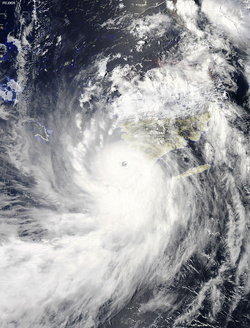Arrocane Arlene
 Arlene at it's record peak intensity over the Gulf of Ardonia on May 21 | |
| Meteorological history | |
|---|---|
| Formed | May 17, 2019 |
| Extratropical | May 27, 2019 |
| Dissipated | May 30, 2019 |
| Category 5 major arrocane | |
| 1-minute sustained (AAWS/NWS) | |
| Highest winds | 180 mph (290 km/h) (Fastest 1-minute sustained winds ever recorded) |
| Lowest pressure | 899 mbar (hPa); 26.55 inHg (Lowest ever recorded) |
| Overall effects | |
| Fatalities | 113 total |
| Injuries | 2,500+ |
| Missing | 32 |
| Damage | ≥$24.9 billion (2019 AC) (Preliminary damage results via NAC/NWS Port Kazu) |
| Areas affected |
|
|
| |
| Part of the 2019 Ardonia arrocane season | |
Arrocane Arlene was a catastrophic and historic tropical cyclone—the most powerful arrocane ever recorded in the Ardonia basin. Forming in mid-May 2019, the storm became the earliest Category 5 arrocane on record and eventually broke over a dozen all-time records for intensity, windspeed, rainfall, and storm surge. Arlene reached peak sustained winds of 180 mph (290 km/h) and a central pressure of 899 mbar, the strongest and most intense values ever observed in the basin.
Arlene made three destructive landfalls in Cydonia—first in Po'Hatu at Category 5 intensity, then in Meridian as a Category 4, and finally in Port Kazu as a Category 3. The storm caused catastrophic damage and deadly flooding as it stalled over the region. In total, Arlene left 113 people dead, over 2,500 injured, and at least $24.9 billion AC in damages. Due to its historic impact, the name "Arlene" was retired following the season.
Meteorological history

Tropical storm (40–74 mph, 64–120 km/h)
Category 1 (75–94 mph, 121–152 km/h)
Category 2 (95–114 mph, 153–184 km/h)
Category 3 (115–129 mph, 185–209 km/h)
Category 4 (130–159 mph, 210–259 km/h)
Category 5 (≥ 160 mph, ≥ 260 km/h)
Unknown
| Rank | Arrocane | Season | Windspeed (MPH) |
|---|---|---|---|
| 1 | 5 Milton | 2019 | 200 mph (320 km/h) |
| 2 | 5 Gilbert | 2020 | 190 mph (310 km/h) |
| 3 | 5 Arlene | 2019 | 180 mph (290 km/h) |
| 4 | 5 Katrina | 2019 | 175 mph (282 km/h) |
| 5 | 5 Nine | 1865 | 165 mph (266 km/h) |
| 6 | 5 Lee | 2020 | 160 mph (260 km/h) |
| 7 | 4 Michael | 2020 | 155 mph (249 km/h) |
| 8 | 4 Florence | 2019 | 150 mph (240 km/h) |
| 9 | 4 Seven | 1865 | 145 mph (233 km/h) |
| 4 Wilma | 2019 |
Arrocane Arlene originated from a broad area of low pressure in the southern Gulf of Ardonia on May 16. Favorable environmental conditions—including abnormally warm sea surface temperatures and low wind shear—allowed the disturbance to gradually consolidate. It was declared a tropical depression by the NAC on May 17 and quickly intensified into Tropical Storm Arlene later that day.
| Rank | Arrocane | Season | Pressure | |
|---|---|---|---|---|
| hPa | inHg | |||
| 1 | Milton | 2019 | 865 | 25.54 |
| 2 | Gilbert | 2020 | 881 | 26.02 |
| 3 | Arlene | 2019 | 899 | 26.55 |
| 4 | Katrina | 2019 | 901 | 26.61 |
| 5 | Nine | 1865 | 911 | 26.90 |
| 6 | Lee | 2020 | 918 | 27.11 |
| 7 | Florence | 2019 | 925 | 27.32 |
| 8 | Seven | 1865 | 929 | 27.43 |
| 9 | Michael | 2020 | 930 | 27.46 |
| 10 | Wilma | 2019 | 931 | 27.49 |
| Source: NAC/NWS | ||||
By May 18, Arlene had reached Category 1 intensity and began a period of explosive intensification. Over the next 48 hours, the storm progressed through multiple intensity categories, achieving Category 5 status on May 20 with sustained winds of 180 mph (290 km/h) and a central pressure of 899 mbar—making it the most intense and strongest arrocane ever recorded in the Ardonia basin.
Arlene made its first landfall on May 22 in Po'Hatu, Cydonia as a high-end Category 5 arrocane, with sustained winds of 175 mph and a pressure of 908 mbar. Despite its small size, the island sustained widespread devastation. Hours later, the storm made a second landfall in Meridian at Category 4 strength with winds of 155 mph and a pressure of 931 mbar. Arlene weakened slightly before striking Port Kazu as a Category 3 with 115 mph winds and a pressure of 976 mbar. The storm then stalled over the city as a strong tropical storm, unleashing catastrophic flooding and storm surge across the area.
Arlene retained tropical storm strength for nearly two more days as it drifted inland and across central Cydonia, before weakening and eventually becoming extratropical on May 27. The system finally dissipated over the northern Gulf of Ardonia on May 30.
Preparations
Ahead of Arlene's landfall, the National Arrocane Center and NWS Port Kazu issued the highest possible alerts across southern Cydonia and nearby coastal regions. Mandatory evacuations were ordered for the Trinity Islands, Po’Hatu, and Meridian, while emergency shelters were established inland. The NAC coordinated with local authorities to deploy response teams, and military forces were placed on standby throughout the region.
Impact
| Rank | Arrocane | Season | Damage |
|---|---|---|---|
| 1 | 5 Arlene | 2019 | $158 billion |
| 2 | 5 Milton | 2019 | $75 billion |
| 3 | 4 Katrina | 2019 | $59 billion |
| 4 | 3 Florence | 2019 | $45 billion |
| 5 | 4 Rita | 2019 | $37.6 billion |
| 6 | 4 Wilma | 2019 | $29.5 billion |
| 7 | 3 Victor | 2019 | $19.9 billion |
| 8 | 1 Camille | 2019 | $16 billion |
| 9 | 4 Nine | 1865 | $10.2 billion |
| 10 | 4 Seven | 1865 | $5.87 billion |
Arlene caused catastrophic damage across wide swaths of Ardonia. The worst devastation occurred in Cydonia, where entire towns were flattened, and massive coastal flooding occurred due to storm surge peaking at 50.75 ft. Rainfall totals reached a staggering 250.59 inches in localized areas, and the highest recorded wave height of 99.3 feet was observed off the coast of Kaeru.
In total, Arlene caused at least $24.9 billion AC in damage, making it the costliest arrocane in Ardonian history. The storm killed 113 people and left over 2,500 injured, with 32 individuals still unaccounted for. Infrastructure in Meridian, Port Kazu, and Blade Island was heavily damaged or destroyed, and agricultural losses in the Phaethon lowlands were described as near-total.
Aftermath
In the storm’s aftermath, large-scale rescue and recovery efforts were launched by the NAC, regional governments, and international aid organizations. Emergency supplies were airlifted to isolated areas, while engineers worked to restore power and reopen vital roadways. The government of Cydonia declared a state of emergency, and long-term rebuilding efforts were projected to take multiple years.
Due to its unprecedented strength and devastating impact, the name "Arlene" was officially retired from the naming lists. In the months following the storm, meteorological agencies began reevaluating rapid intensification protocols and landfall response strategies, marking Arlene as a defining event in the history of Ardonia's meteorology.
Records
Arlene broke a total of 15 records in the Ardonian basin:
- Earliest Category 5 arrocane on record
- Costliest arrocane on record (≥$24.9 billion AC)
- Deadliest arrocane on record (113 confirmed fatalities)
- Strongest sustained winds on record (180 mph)
- Lowest pressure on record (899 mbar)
- First storm to make landfall at Category 5 intensity
- Most intense landfall windspeed (175 mph)
- Most intense landfall pressure (908 mbar)
- First A-named storm to reach tropical storm strength
- Highest recorded storm surge (50.75 ft)
- Most rainfall dropped by a single storm (250.59 inches)
- Highest confirmed wave height (99.3 ft)
- Longest duration of Category 5 winds (1 day, 6 hours)
- Smallest eye diameter (4.4 miles)
- Fastest intensification: 70 mph and 69 mbar drop in 24 hours
